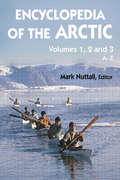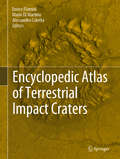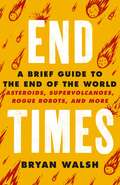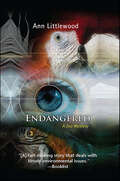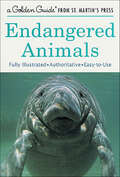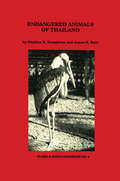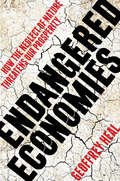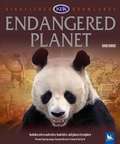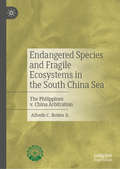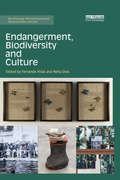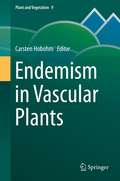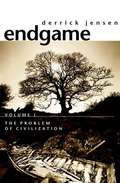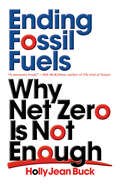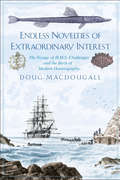- Table View
- List View
Encyclopedia of the Arctic
by Mark NuttallWith detailed essays on the Arctic's environment, wildlife, climate, history, exploration, resources, economics, politics, indigenous cultures and languages, conservation initiatives and more, this Encyclopedia is the only major work and comprehensive reference on this vast, complex, changing, and increasingly important part of the globe. Including 305 maps.This Encyclopedia is not only an interdisciplinary work of reference for all those involved in teaching or researching Arctic issues, but a fascinating and comprehensive resource for residents of the Arctic, and all those concerned with global environmental issues, sustainability, science, and human interactions with the environment.
Encyclopedia of the City
by Roger W. CavesThe Encyclopedia of the City focuses on the key topics encountered by undergraduates and scholars in urban studies and allied fields. Contributors include major theoreticians and practitioners, and on other individuals, groups, and organizations which study the city or practice in a field that directly or indirectly affects the city, the Encyclopedia necessarily adopts an interdisciplinary and multidisciplinary perspective. A solid but also provocative starting point for wider exploration of the city, this is a first-class work of reference that will be an essential resource for independent study as well as a useful aid in teaching.
Encyclopedia of the World's Coastal Landforms
by Eric BirdThis unique richly-illustrated account of the landforms and geology of the world's coasts, presented in a country-by-country (state-by-state) sequence, assembles a vast amount of data and images of an endangered and increasingly populated and developed landform. An international panel of 138 coastal experts provides information on "what is where" on each sector of coast, together with explanations of the landforms, their evolution and the changes taking place on them. As well as providing details on the coastal features of each country (state or county) the compendium can be used to determine the extent of particular features along the world's coasts and to investigate comparisons and contrasts between various world regions. With more than 1440 color illustrations and photos, it is particularly useful as a source of information prior to researching or just visiting a sector of coast. References are provided to the current literature on coastal evolution and coastline changes.
Encyclopedic Atlas of Terrestrial Impact Craters
by Enrico Flamini Mario Di Martino Alessandro ColettaThis comprehensive atlas explains the genesis and evolution of impact known craters on Earth, presenting a wealth of radar images from the Italian COSMO-SkyMed satellites that were acquired at the same frequency, spatial resolution, operating mode, and illumination, allowing excellent comparison of different impact structures. It also discusses in detail the processes that have hidden or erased terrestrial impact craters, and clearly explains the basic principles of remote sensing and the COSMO-SkyMed system and radar instruments. Also, the optical satellite remote sensing technique used to produce the optical images is described. The main section documents each of the exposed craters officially recognized as caused by meteoritic impact, presenting a table with the COSMO-SkyMed radar image and, where available, a Sentinel optical image and a photograph taken in situ. A short accompanying text reports the location, context, geographical coordinates, and other ancillary information to support future researches.
End Times: A Brief Guide to the End of the World
by Bryan WalshWhat is going to cause our extinction?How can we save ourselves and our future?End Times answers the most important questions facing humankindEnd Times is a compelling work of skilled reportage that peels back the layers of complexity around the unthinkable-and inevitable-end of humankind. From asteroids and artificial intelligence to volcanic supereruption to nuclear war, 15-year veteran science reporter and TIME editor Bryan Walsh provides a stunning panoramic view of the most catastrophic threats to the human race.In End Times, Walsh examines threats that emerge from nature and those of our own making: asteroids, supervolcanoes, nuclear war, climate change, disease pandemics, biotechnology, artificial intelligence, and extraterrestrial intelligence. Walsh details the true probability of these world-ending catastrophes, the impact on our lives were they to happen, and the best strategies for saving ourselves, all pulled from his rigorous and deeply thoughtful reporting and research.Walsh goes into the room with the men and women whose job it is to imagine the unimaginable. He includes interviews with those on the front lines of prevention, actively working to head off existential threats in biotechnology labs and government hubs. Guided by Walsh's evocative, page-turning prose, we follow scientific stars like the asteroid hunters at NASA and the disease detectives on the trail of the next killer virus.Walsh explores the danger of apocalypse in all forms. In the end, it will be the depth of our knowledge, the height of our imagination, and our sheer will to survive that will decide the future.
End Times: Asteroids, Supervolcanoes, Plagues and More
by Bryan WalshNewsweek and Bloomberg popular science and investigative journalist Bryan Walsh explores the history of extinction and offers a cutting-edge examination of existential risk, the dangerous mistakes we have yet to pay for, and concrete steps we can take to protect ourselves and future-proof our civilization.What is going to cause our extinction?How can we save ourselves and our future?End Times answers the most important questions facing humankindEnd Times is a compelling work of skilled reportage that peels back the layers of complexity around the unthinkable-and inevitable-end of humankind. From asteroids and artificial intelligence to volcanic supereruption to nuclear war, 15-year veteran science reporter and TIME editor Bryan Walsh provides a stunning panoramic view of the most catastrophic threats to the human race.In End Times, Walsh examines threats that emerge from nature and those of our own making: asteroids, supervolcanoes, nuclear war, climate change, disease pandemics, biotechnology, artificial intelligence, and extraterrestrial intelligence. Walsh details the true probability of these world-ending catastrophes, the impact on our lives were they to happen, and the best strategies for saving ourselves, all pulled from his rigorous and deeply thoughtful reporting and research.Walsh goes into the room with the men and women whose job it is to imagine the unimaginable. He includes interviews with those on the front lines of prevention, actively working to head off existential threats in biotechnology labs and government hubs. Guided by Walsh's evocative, page-turning prose, we follow scientific stars like the asteroid hunters at NASA and the disease detectives on the trail of the next killer virus.Walsh explores the danger of apocalypse in all forms. In the end, it will be the depth of our knowledge, the height of our imagination, and our sheer will to survive that will decide the future.
End of Hyper Growth in China?
by Jun ZhangIn this book, Dr. Jun Zhang rebuts the widely-held view that Chinese economic growth is unsustainable due to low consumption and a reliance on exports and enormous fixed-asset investments. Though many believe this "structural imbalance" of the Chinese economy will become a serious problem in the long run, Zhang holds a bullish long-term outlook owing to China's long-term economic development. For Zhang, China's structural problems are greatly exaggerated and certain structures, such as regional governing entities, ensure that China will not face the same economic issues that Japan encountered. Through regional competition, regional governments will persevere; Zhang predicts that China will overtake the US as a superpower. Zhang concludes by acknowledging the real dangers facing China's economy, and offering advice on the reforms needed to ensure continued growth.
Endangered
by Mitch TobinSince 1973, the Endangered Species Act has served as our nation's legislative ark for imperiled wildlife. But our toughest and most controversial environmental law has only recovered a handful of the more than 1,300 species under its protection. In Endangered, award-winning journalist Mitch Tobin uses firsthand accounts to show why so many species are at risk of extinction.For nearly seven years, Tobin reported from the front lines of Endangered Species Act battles. He crisscrossed the Southwest-our hottest, driest, fastest-growing region-in search of wildlife driven to the brink of extinction and solutions to the crisis. Tobin discovered that this region, with its urban sprawl, wasteful water use, and vulnerability to climate change, provides a snapshot of the issues facing species throughout the world.Yet in one of the continent's hot spots for biodiversity, Tobin also found compelling examples of collaboration. With these examples in mind, he advocates for a set of innovative policies that can preserve the species and wild places that sustain us all.Mitch Tobin worked as a journalist from 1999 to 2006, covering wildlife, wildfires, and other environmental issues for the Tucson Citizen, Arizona Daily Star, and High Country News. Endangered grew out of Tobin's yearlong series on Arizona's endangered species, which was a finalist for the John B. Oakes Award for Distinguished Environmental Journalism. His work was honored in the Best of the West competition and received first prizes from the Arizona Press Club and Arizona Associated Press Managing Editors. Today, Tobin serves as a consultant to leading conservation groups and foundations.
Endangered (Zoo Mysteries)
by Ann LittlewoodWhen a drug bust reveals exotic animals at a marijuana grow site, zookeeper Iris Oakley and a colleague ride to the rescue in the zoo's van. But instead of pets they find smuggled parrots and tortoises destined for sale to unscrupulous or unsuspecting collectors. Iris also discovers a woman who escaped the bust—dead.The murder and the drug ops are the cops' problem, but Iris is determined to break the criminal pipeline that snatches rare animals from the wild and leaves them neglected in old barns. The zoo's facilities are full, and Iris ends up with two macaws shrieking in her basement. Next, brothers from the busted family, both murder suspects, invade her home, demanding information they think their father passed on as he, too, died at the scene.Iris flees with her child, but soon realizes she must be on the offensive. People she counts on are not who they claim to be. Sorting through baffling clues and tripping over secrets old and new, Iris soon learns that everyone has an agenda. And at least one of them is deadly....
Endangered Animals (Golden Guides from St. Martin's Press)
by George S. FichterThis eBook is best viewed on a color device.Wildlife is in danger everywhere. In this timely look at the plight of endangered animals, you will find:-A survey of hundreds of animal species that are in trouble-Descriptions of the many causes of endangerment and the controversies surrounding current laws-Fascinating stories about the efforts of people to rescue species and restore harmony and balance in nature-More than a hundred dramatic full-color illustrationsHere is a valuable resource for nature lovers-for anyone, in fact, who is concerned with the fate of animals and the future of life on this planet.
Endangered Animals of Thailand
by Stephen R. HumphreyThis work presents the state of knowledge on the endangered and threatened species of Thailand. Its pragmatic purpose is to improve Thailand’s future by providing access to technical guidance for planning development projects or other land-use changes. This information also should stimulate naturalists, professional biologists, or anyone who wishes to learn about the status of animals in Thailand. Which species are now on the brink of extinction from Thailand, and why? How can the Thai people reorganize themselves to reverse the course of destruction? Can ways be found for both the people and the rest of the fauna to prosper? Another purpose is to present a case study of the effects of longterm development for human use on the biological diversity of a tropical country.
Endangered Economies: How the Neglect of Nature Threatens Our Prosperity
by Geoffrey HealIn the decades since Geoffrey Heal began his field-defining work in environmental economics, one central question has animated his research: "Can we save our environment and grow our economy?" This issue has become only more urgent in recent years with the threat of climate change, the accelerating loss of ecosystems, and the rapid industrialization of the developing world. Reflecting on a lifetime of experience not only as a leading voice in the field, but as a green entrepreneur, activist, and advisor to governments and global organizations, Heal clearly and passionately demonstrates that the only way to achieve long-term economic growth is to protect our environment.Writing both to those conversant in economics and to those encountering these ideas for the first time, Heal begins with familiar concepts, like the tragedy of the commons and unregulated pollution, to demonstrate the underlying tensions that have compromised our planet, damaging and in many cases devastating our natural world. Such destruction has dire consequences not only for us and the environment but also for businesses, which often vastly underestimate their reliance on unpriced natural benefits like pollination, the water cycle, marine and forest ecosystems, and more. After painting a stark and unsettling picture of our current quandary, Heal outlines simple solutions that have already proven effective in conserving nature and boosting economic growth. In order to ensure a prosperous future for humanity, we must understand how environment and economy interact and how they can work in harmony-lest we permanently harm both.
Endangered Economies: How the Neglect of Nature Threatens Our Prosperity
by Geoffrey HealIn the decades since Geoffrey Heal began his field-defining work in environmental economics, one central question has animated his research: "Can we save our environment and grow our economy?" This issue has become only more urgent in recent years with the threat of climate change, the accelerating loss of ecosystems, and the rapid industrialization of the developing world. Reflecting on a lifetime of experience not only as a leading voice in the field, but as a green entrepreneur, activist, and advisor to governments and global organizations, Heal clearly and passionately demonstrates that the only way to achieve long-term economic growth is to protect our environment. Writing both to those conversant in economics and to those encountering these ideas for the first time, Heal begins with familiar concepts, like the tragedy of the commons and unregulated pollution, to demonstrate the underlying tensions that have compromised our planet, damaging and in many cases devastating our natural world. Such destruction has dire consequences not only for us and the environment but also for businesses, which often vastly underestimate their reliance on unpriced natural benefits like pollination, the water cycle, marine and forest ecosystems, and more. After painting a stark and unsettling picture of our current quandary, Heal outlines simple solutions that have already proven effective in conserving nature and boosting economic growth. In order to ensure a prosperous future for humanity, we must understand how environment and economy interact and how they can work in harmony—lest we permanently harm both.
Endangered Maize: Industrial Agriculture and the Crisis of Extinction
by Helen Anne CurryCharting the political, social, and environmental history of efforts to conserve crop diversity. Many people worry that we're losing genetic diversity in the foods we eat. Over the past century, crop varieties standardized for industrial agriculture have increasingly dominated farm fields. Concerned about what this transition means for the future of food, scientists, farmers, and eaters have sought to protect fruits, grains, and vegetables they consider endangered. They have organized high-tech genebanks and heritage seed swaps. They have combed fields for ancient landraces and sought farmers growing Indigenous varieties. Behind this widespread concern for the loss of plant diversity lies another extinction narrative that concerns the survival of farmers themselves, a story that is often obscured by urgent calls to collect and preserve. Endangered Maize draws on the rich history of corn in Mexico and the United States to uncover this hidden narrative and show how it shaped the conservation strategies adopted by scientists, states, and citizens. In Endangered Maize, historian Helen Anne Curry investigates more than a hundred years of agriculture and conservation practices to understand the tasks that farmers and researchers have considered essential to maintaining crop diversity. Through the contours of efforts to preserve diversity in one of the world's most important crops, Curry reveals how those who sought to protect native, traditional, and heritage crops forged their methods around the expectation that social, political, and economic transformations would eliminate diverse communities and cultures. In this fascinating study of how cultural narratives shape science, Curry argues for new understandings of endangerment and alternative strategies to protect and preserve crop diversity.
Endangered Planet (Kingfisher Knowledge)
by Tony Juniper David BurnieEndangered Planet is a timely examination of the state of the earth's ecosystems. Today, humans influence every natural habitat on the planet. The consequences can be devastating--dozens of species are wiped out each year, coasts and oceans are fouled with oil spills, and grasslands and forests are destroyed to feed the appetite of modern agriculture. Endangered Planet also reveals how renewable energy, recycling, and wildlife protection will play a key role in the survival of Earth.
Endangered Species Threatened Convention: The Past, Present and Future of CITES, the Convention on International Trade in Endangered Species of Wild Fauna and Flora
by Barnabas DicksonThe Convention on International Trade in Endangered Species (CITES) is the best known and most controversial of international conservation treaties. Since it came into force 25 years ago, debate has raged over its most basic assumptions. CITES treats the international trade in wildlife as the most important threat to the continued existence of wild species. It offers a prescription of trade bans and restrictions for endangered species. However, it is now generally acknowledged that for most species habitat loss is a much more significant threat. Some argue that the CITES remedy actually exacerbates the problem by removing the incentive to conserve wildlife habitat. This collection of essays, the first of its kind, charts the controversies and changes within CITES. It provides case studies of the way CITES has dealt with particular species and notes the growing role of the South in shaping the direction of the treaty. It considers the role of sustainable use, the precautionary principle and unilateralism within CITES. Finally, it examines options for the future of CITES. Implicit within a number of the contributions is the recognition that questions of wildlife conservation cannot be divorced from wider issues of land use, development and social justice. This book provides an essential resource for policy makers, practitioners, academics and students concerned with conservation, development and trade.
Endangered Species and Fragile Ecosystems in the South China Sea: The Philippines v. China Arbitration
by Alfredo C. Robles, Jr.This book presents an in-depth analysis of the environmental issues raised in the South China Sea Arbitration Awards, which have not attracted as much attention in the Philippines as the “nine-dash line”. Specifically it focuses on the conservation of endangered species and the conservation of fragile ecosystems in the South China Sea. The aims of the book are two-fold. First, it seeks to explain the Philippine perspective on the environmental aspects of its dispute with China. The book reconstructs the Philippine perspective in part by consulting several dozens of the hundreds of documents that the Philippines submitted to the Tribunal. Some of these documents were classified as secret and would thus have never been made available to the public had it not been for the arbitration. Second, it attempts to explain the decisions of the Tribunal on jurisdiction and admissibility as well as the decisions on the merits of the dispute. The book does this by consulting not only the two Awards but also the hundreds of pages of transcripts, expert reports, supplemental submissions and written responses by the Philippines to questions posed by the Tribunal.
Endangered and Disappearing Birds of the Midwest
by Matt WilliamsFrom the birds who wake us in the morning with their cheerful chorus to those who flock to our feeders and brighten a gloomy winter day, birds fascinate us with their lively and interesting behavior and provide essential services from controlling pest populations to pollinating crops. And yet for all the benefits they provide, many species across Minnesota, Wisconsin, Illinois, Iowa, Indiana, Michigan, and Ohio are in danger of extinction due to loss of habitat, agricultural expansion, changing forest conditions, and interactions with humans. In Endangered and Disappearing Birds of the Midwest, Matt Williams profiles forty of the most beautiful and interesting birds who winter, breed, or migrate through the Midwest and whose populations are most in danger of disappearing from the region. Each profile includes the current endangered status of the species, a description of the bird's vocal and nesting patterns, and tips to help readers identify them, along with stunning color images and detailed migration maps. An exquisite and timely examination of our feathered friends, Endangered and Disappearing Birds of the Midwest is a call to action to protect these vulnerable and gorgeous creatures that enliven our world.
Endangerment, Biodiversity and Culture (Routledge Environmental Humanities)
by Fernando Vidal and Nélia DiasThe notion of Endangerment stands at the heart of a network of concepts, values and practices dealing with objects and beings considered threatened by extinction, and with the procedures aimed at preserving them. Usually animated by a sense of urgency and citizenship, identifying endangered entities involves evaluating an impending threat and opens the way for preservation strategies. Endangerment, Biodiversity and Culture looks at some of the fundamental ways in which this process involves science, but also more than science: not only data and knowledge and institutions, but also affects and values. Focusing on an "endangerment sensibility," it encapsulates tensions between the normative and the utilitarian, the natural and the cultural. The chapters situate that specifically modern sensibility in historical perspective, and examine central aspects of its recent and present forms. This timely volume offers the most cutting-edge insights into the Environmental Humanities for researchers working in Environmental Studies, History, Anthropology, Sociology and Science and Technology Studies.
Endemism in Vascular Plants
by Carsten HobohmThe book is the first comprehensive analysis of the macroecology and geobotany of endemic vascular plants with case-studies and analyses from different regions in the world. Endemism is a pre-extinction phenomenon. Endemics are threatened with extinction. Due to international nature conservation policies and due to the perception of the public the concept's importance is increasing. Endemism can result from different biological and environmental processes. Depending on the process conservation measures should be adapted. Endemic vascular plant taxa, in the setting of their species composition and vegetation types are important features of landscapes and indicators of the quality of relating habitats. The book is an important basis for biologists, ecologists, geographers, planners and managers of nature reserves and national parks, and people generally interested in nature conservation and biogeography of vascular plants.
Endgame, Volume 1: The Problem of Civilization
by Derrick JensenEndgame, Volume 1 builds on a series of simple but increasingly provocative premises: for example, "The needs of the natural world are more important than the needs of any economic system" and "Love does not imply pacifism." A brilliant weaving together of piercing analysis and elegant prose, Endgame leads us to see that we can re-imagine our world. Derrick Jensen is the acclaimed author of A Language Older Than Words and The Culture of Make Believe, among many others. Author, teacher, activist, small farmer, and leading voice of uncompromising dissent, he regularly stirs auditoriums across the country with revolutionary spirit. Jensen holds a degree in creative writing from Eastern Washington University, a degree in mineral engineering physics from the Colorado School of Mines, and has taught at Eastern Washington University and Pelican Bay State Prison.
Ending Fossil Fuels: Why Net Zero is Not Enough
by Holly Jean BuckEnding the fossil fuel industry is the only credible path for climate policyAround the world, countries and companies are setting net-zero carbon emissions targets. But what will it mean if those targets are achieved? One possibility is that fossil fuel companies will continue to produce billions of tons of atmospheric CO2 while relying on a symbiotic industry to scrub the air clean. Focusing on emissions draws our attention away from the real problem: the point of production.The fossil fuel industry must come to an end but will not depart willingly; governments must intervene. By embracing a politics of rural-urban coalitions and platform governance, climate advocates can build the political power needed to nationalize the fossil fuel industry and use its resources to draw carbon out of the atmosphere.
Ending Hunger: The quest to feed the world without destroying it
by Anthony WarnerNutritionists tell you to eat more fish. Environmentalists tell you to eat less fish. Apparently they are both right. It's the same thing with almonds, or quinoa, or a hundred other foods. But is it really incumbent on us as individuals to resolve this looming global catastrophe? From plastic packaging to soil depletion to flatulent cows, we are bombarded with information about the perils of our food system. Drawing on years of experience within the food industry, Anthony Warner invites us to reconsider what we think we know. In Ending Hunger, he uncovers the parallels between eating locally and 1930s fascism, promotes the potential for good in genetic modification and dispels the assumption that population growth is at the heart of our planetary woes.
Endless Forms: The Secret World of Wasps
by Seirian Sumner“A book that draws us in to the strange beauty of what we so often run away from.” — Robin Ince, author of The Importance of Being InterestedIn this eye-opening and entertaining work of popular science in the spirit of The Mosquito, Entangled Life, and The Book of Eels, a leading behavioural ecologist transforms our understanding of wasps, exploring these much-maligned insects’ secret world, their incredible diversity and complex social lives, and revealing how they hold our fragile ecosystem in balance.Everyone worries about the collapse of bee populations. But what about wasps? Deemed the gangsters of the insect world, wasps are winged assassins with formidable stings. Conduits of Biblical punishment, provokers of fear and loathing, inspiration for horror movies: wasps are perhaps the most maligned insect on our planet. But do wasps deserve this reputation?Endless Forms opens our eyes to the highly complex and diverse world of wasps. Wasps are 100 million years older than bees; there are ten times more wasp species than there are bees. There are wasps that spend their entire lives sealed inside a fig; wasps that turn cockroaches into living zombies; wasps that live inside other wasps. There are wasps that build citadels that put our own societies to shame, marked by division of labor, rebellions and policing, monarchies, leadership contests, undertakers, police, negotiators, and social parasites. Wasps are nature’s most misunderstood insect: as predators and pollinators, they keep the planet’s ecological balance in check. Wasps are nature’s pest controllers; a world without wasps would be just as ecologically devastating as losing the bees, or beetles, or butterflies.Wasps are diverse and beautiful by every measure, and they are invaluable to planetary health, Professor Sumner reminds us; we’d do well to appreciate them as much as their cuter cousins, the bees.
Endless Novelties of Extraordinary Interest: The Voyage of H.M.S. Challenger and the Birth of Modern Oceanography
by Doug MacdougallA gripping tale of exploration aboard H.M.S. Challenger, an expedition that laid the foundations for modern oceanography From late 1872 to 1876, H.M.S. Challenger explored the world’s oceans. Conducting deep sea soundings, dredging the ocean floor, recording temperatures, observing weather, and collecting biological samples, the expedition laid the foundations for modern oceanography. Following the ship’s naturalists and their discoveries, earth scientist Doug Macdougall engagingly tells a story of Victorian-era adventure and ties these early explorations to the growth of modern scientific fields. In this lively story of discovery, hardship, and humor, Macdougall examines the work of the expedition’s scientists, especially the naturalist Henry Moseley, who rigorously categorized the flora and fauna of the islands the ship visited, and the legacy of John Murray, considered the father of modern oceanography. Macdougall explores not just the expedition itself but also the iconic place that H.M.S. Challenger has achieved in the annals of ocean exploration and science.
